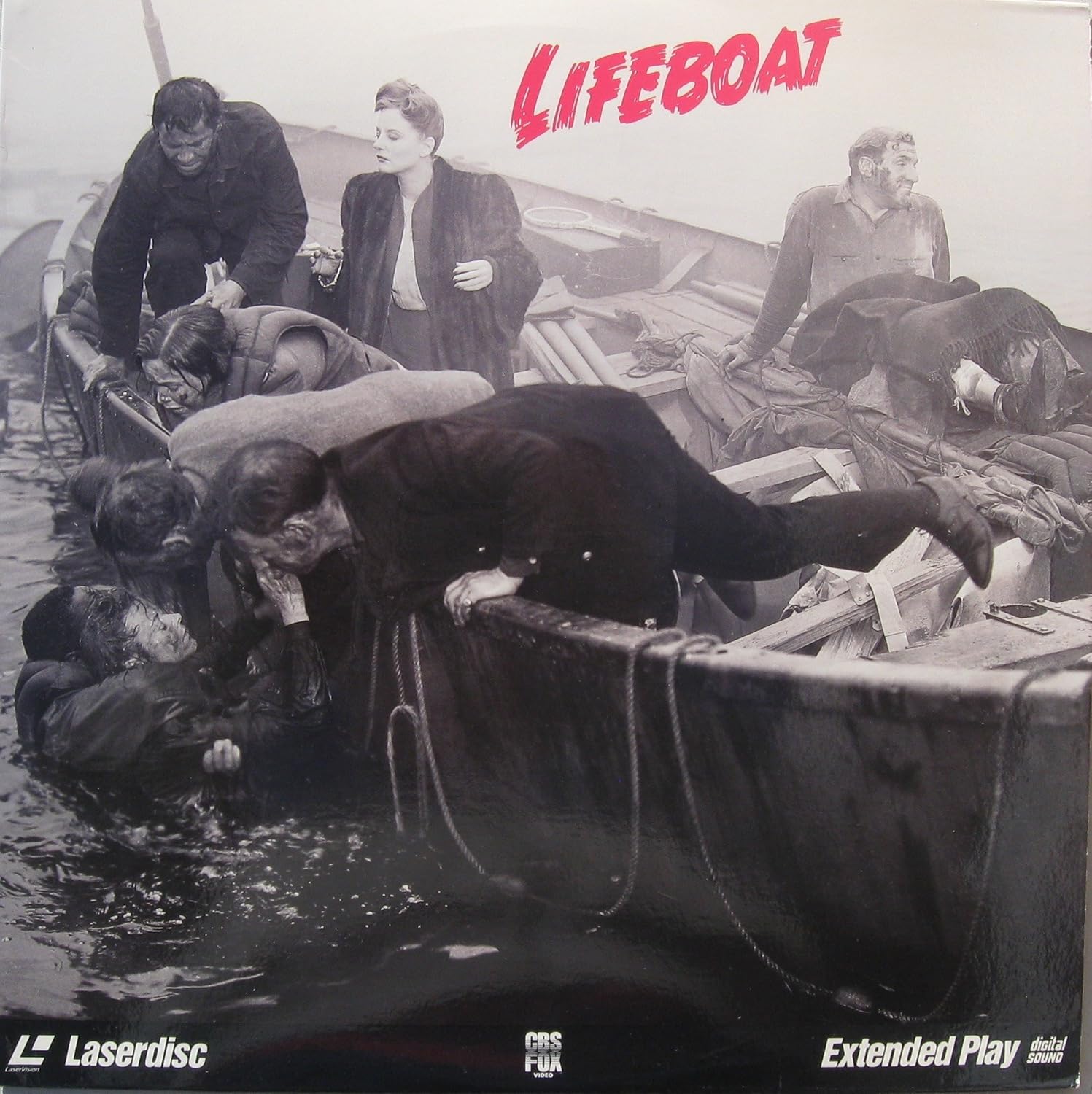- Revisiting contemporary and modern critical appreciation
- Alfred Hitchcock’s dire warning not to underestimate Nazi threat
- Physically demanding shoot injured and almost killed film’s actors
- Piece of tour de force filmmaking is finally finding its audience today
Note: this is part of an ongoing series of 150-odd Hitchcock articles; any dead links are to those not yet published. Subscribe to the email list to be notified when new ones appear.
Lifeboat: Writing on a Classic; Collectors Guide, Pt 2: Shorts and controversies, Pt 3: Home video, Pt 4: Soundtrack and remakes
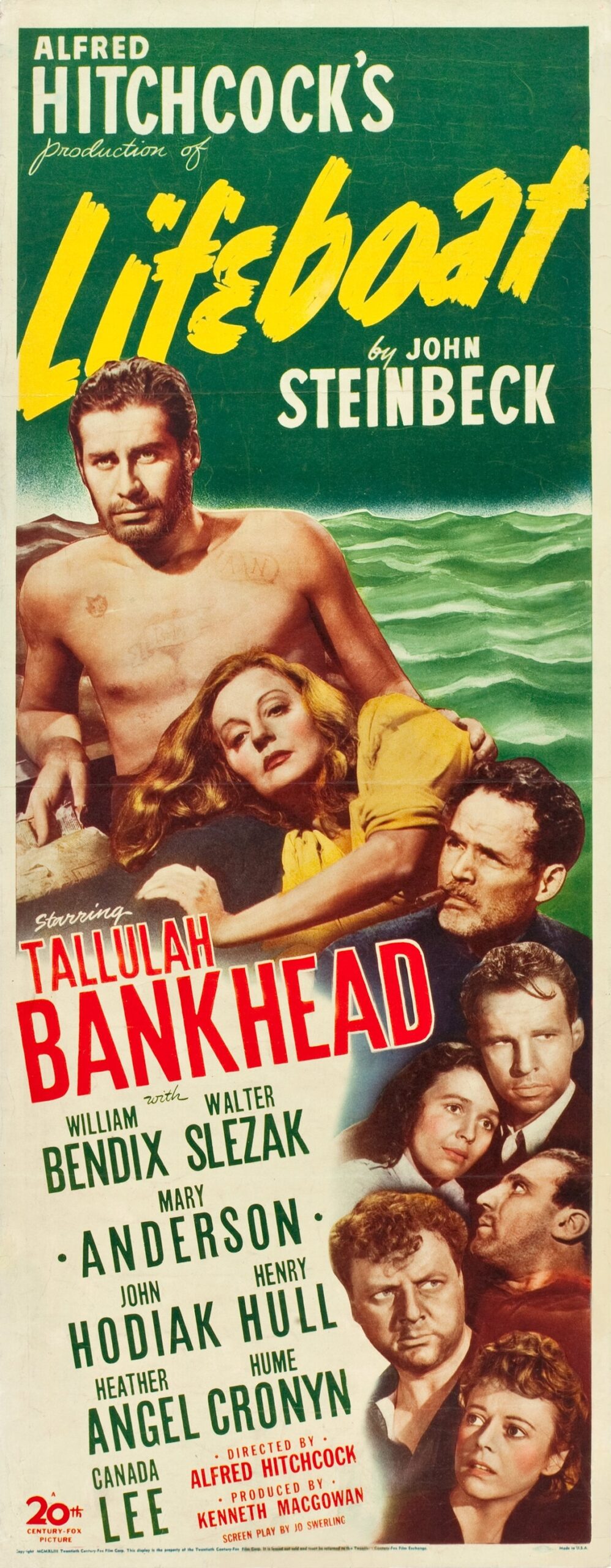
This US insert poster, like most of the film’s publicity, is missing Canada Lee
Lifeboat looks like a big grosser. John Steinbeck’s devastating indictment of the nature of Nazi bestiality, at times an almost clinical, dissecting room analysis, though it is always carried along for strong audience values under the impetus of exciting narrative, emerges as powerful adult motion picture fare. This is one of the first films to deal with the problem of the people of Germany. It is not a problem picture, however, and its sociological implications are neatly and expertly fictionized, Neither is there any effort to solve any problem. Yet a provocative issue is raised, one of a kind calculated to stir theatregoers throughout the country. The question Steinbeck poses is, ‘What can you do with people like that?’ meaning the Germans.
The picture is based on an original idea of director Alfred Hitchcock’s. Hitchcock, from accounts, first asked Steinbeck to write the piece for book publication, figuring that if it turned out a big seller the exploitation value for film purposes would be greatly enhanced. The author, however, would not undertake the more ambitious assignment and wrote the story for screen purposes only, with Jo Swerling handling the adaptation.
Patterned along one of the simplest, most elementary forms of dramatic narration, the action opens and closes on a lifeboat. It’s a lusty, robust story about a group of survivors from a ship sunk by a U-boat. One by one the survivors find precarious refuge on the lifeboat. Finally they pick up a survivor from the German U-boat. Despite the fierce hatred of the suspicious Kovac (John Hodiak), an American of Czech descent, the majority vote against killing the Nazi. He is first tolerated and then welcomed into their midst. They share their food and water with the Nazi. And in the end he repays their trust and confidence with murderous treachery.
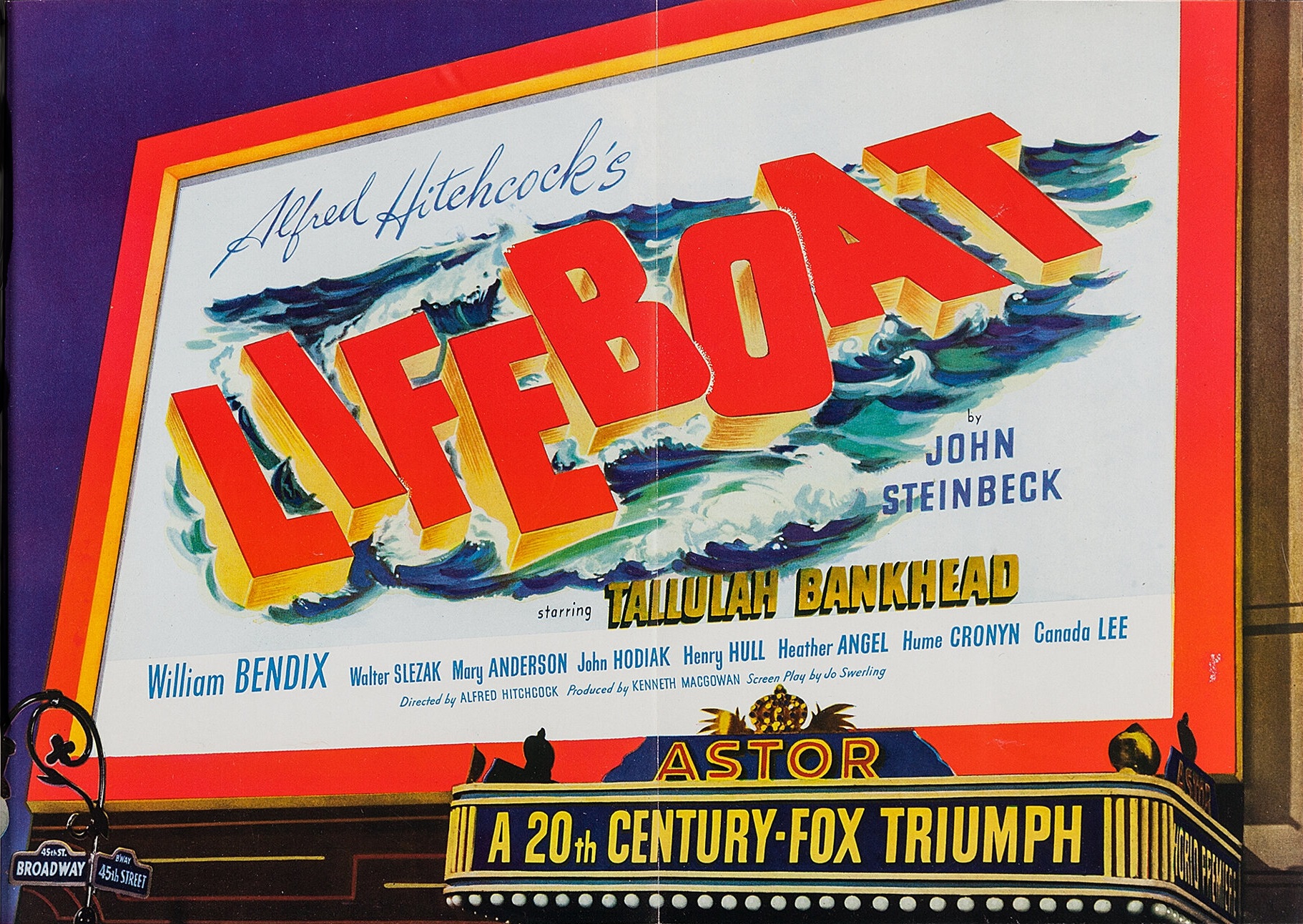
US trade ad
The Nazi, who turns out to be the captain of the submarine which sunk the ship originally, hoards vitamin-food and water while the others go hungry and thirsty. He steers the lifeboat off its course, heading it straight for German waters. He torments the suffering group with extravagant boasts of Nazi ‘master race’ superiority. And when he is finally disposed of there is a momentary sense of loss among the survivors, as if “the motor is gone.” Yet, when the group of Americans and Britishers is confronted later with another Nazi whom they rescue from the sea, they appear likely to repeat their first mistake. Have they so soon forgotten Willie, the first Nazi? Maybe not, but as humans they cannot murder another defenseless human in cold blood.
Walter Slezak, as the fat, greasy, conceited German, comes through with a terrific delineation. Henry Hull as the millionaire, William Bendix as the mariner with a jitterbug complex who loses a leg, John Hodiak as the tough, bitter. Nazi-hater, and Canada Lee as the colored steward, deliver excellent characterizations. Tallulah Bankhead, as Mrs. Porter, a cynical newspaper writer, is not photogenically acceptable in the brief, fiercely romantic interludes. with Hodiak. The camera treats her. unkindly throughout, except in one or two instances. While the film has no top picture names, it is a production that holds first-rate exploitation possibilities. Hitchcock has piloted the piece skillfully, ingenuously developing suspense and action. Despite that it’s a slow starter, the picture, from the beginning, leaves a strong impact and, before too long, develops into the type of suspenseful product with which Hitchcock has always been identified. – Mori, Variety/another
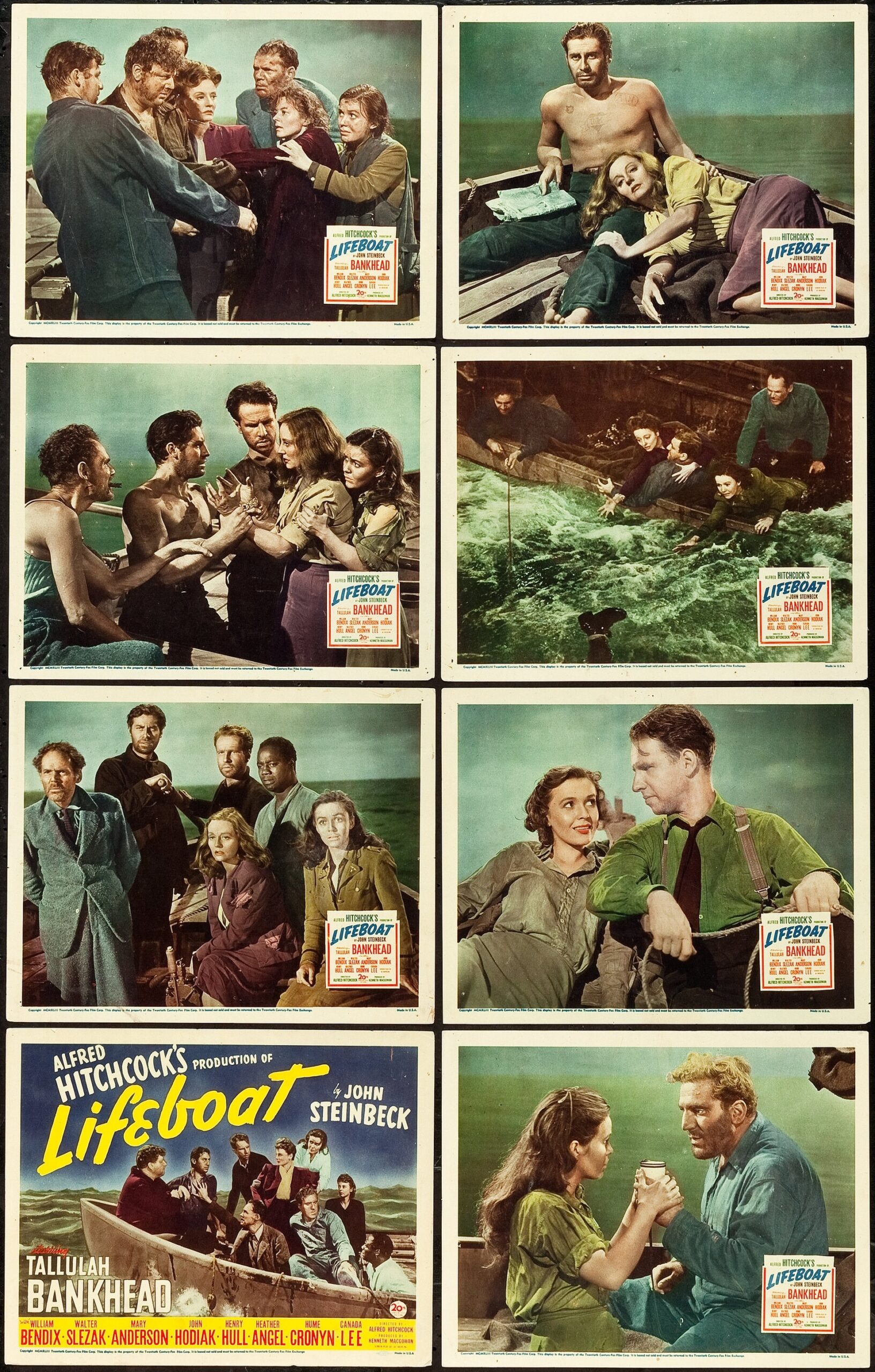
US lobby cards
Hitchcock’s Hand Steers Lifeboat Safely Through Film’s Troubled Sea
The one and only set of Twentieth Century-Fox’s Lifeboat is no more than that: A leaky, clumsy cockleshell on an ocean littered with the wreckage of a Nazi-torpedoed ship.
This saga of a lifeboat and its nine passengers came from a story by John Steinbeck, but the original idea for the film was supplied by its director-producer, Alfred Hitchcock. Obviously delighted by the challenge of manipulating a mobile camera in such crowded quarters, the famous English director further limited his field by developing his narrative without the aid of flashbacks. Fortunately, the resulting tour de force justifies his daring. With his camera arbitrarily lashed to the mast, Hitchcock has not turned out the most satisfying job of his career as dean of cinematic melodrama; nevertheless, there is little doubt that twelve months from now, “Lifeboat” still will stack up as one of the most exciting films of the year.
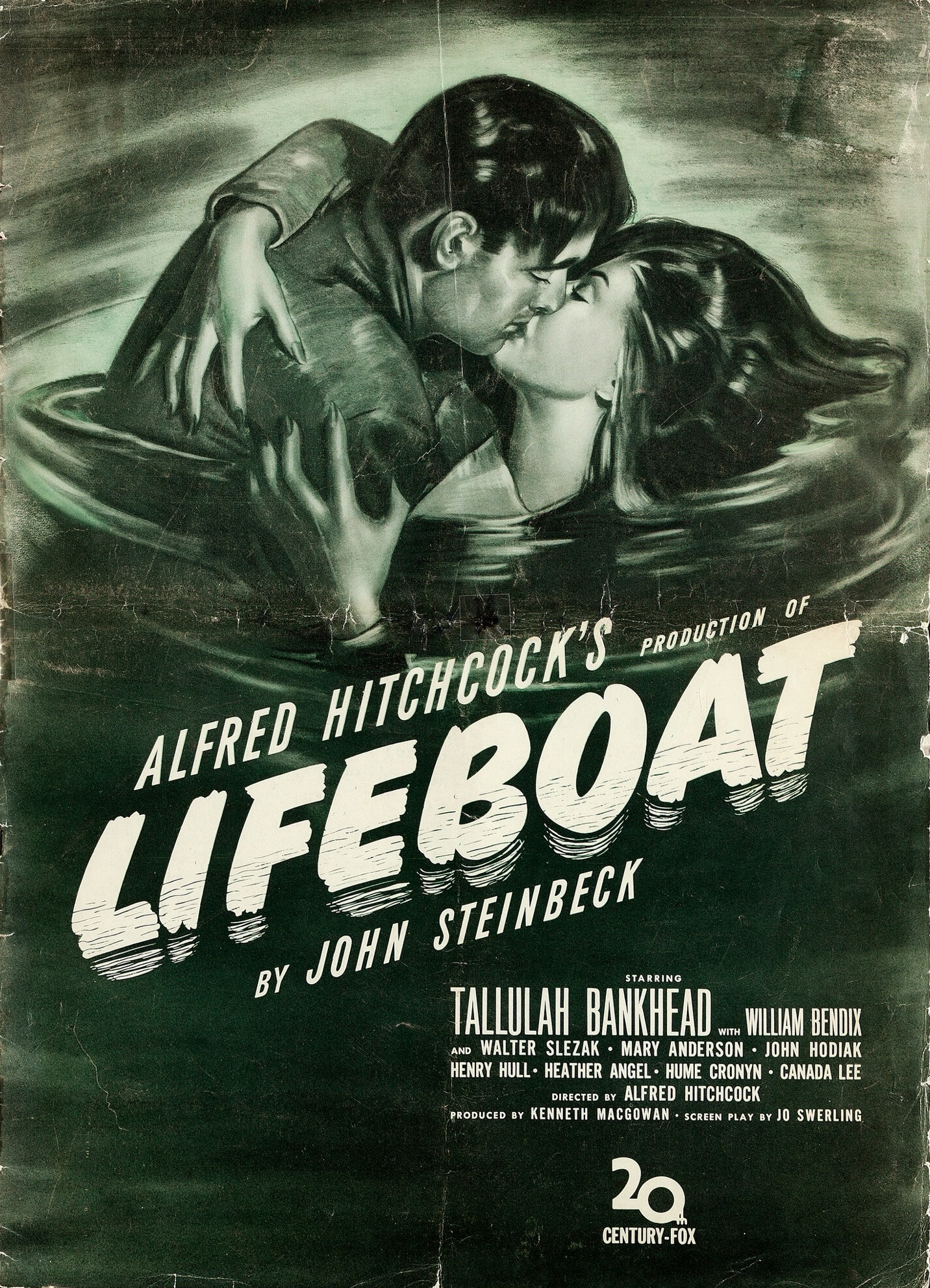
US pressbook
The lifeboat’s passengers, of course, represent a shrewdly arrived-at cross-section of humanity. First aboard is Connie Porter (Tallulah Bankhead), a jaded glamor girl who reports world events for fashionable magazines and manages to escape extinction along with camera, mink coat, jewelry, and similar indispensables for roughing it in an open boat. Then there is Kovac (John Hodiak), a belligerent young leftist from the ship’s engine room; an Army nurse (Mary Anderson); a plutocratic industrialist (Henry Hull), who imagines that he can still do business with the Fascists; a Negro steward (Canada Lee); an ordinary seaman (William Bendix) with gangrene festering in his wounded leg; a radio operator (Hume Cronyn); and an English refugee (Heather Angel), whose baby was dead in her arms when she reached the lifeboat.
That makes eight. The ninth passenger (Walter Slezak) is a survivor of the sub that torpedoed the ship and made the mistake of surfacing to shell her life. boats. Considering his self-imposed limitations, Hitchcock has been quite successful in the matter of opposing wry humor with grim melodrama and, eventually, in making a devastating comment on the inexplicable inner mechanism of the Nazi robot.
As usual, the director heightens his effect by using actors who aren’t fixed personalities in the moviegoer’s book, and the nine castaways, with minor exceptions, come off as vividly contrasting personalities. By reason of his scene, Hitchcock was unable to indulge himself in the traditional whimsy of easing his portly frame briefly into camera focus, But even that problem is solved when John Hodiak, reading a dated, tattered newspaper, reveals a back-page advertisement for Reduco—The Obesity Slayer. The Before and After illustrations are photographs of Hitchcock before and after he started rationing his calories.

Gone fishing: Mary Anderson, Hume Cronyn, John Hodiak and Tallulah Bankhead, Henry Hull and Canada Lee bling for their supper (orig)
On Serson Sea: Despite the stark simplicity of its background, “Lifeboat” was a tricky production to bring into focus. While the dubbed-in shots of storms at sea were photographed off Florida (no offense intended, of course), the cast took to the water in a complacent moat on the studio backlot and in an artificial lake nearby, nicknamed Serson Sea after Fred Serson, the special-effects director, who evidently inherited Moses’ rod. The Sersonification of bad weather was pretty rough on the actors involved. Ordinarily stunt players would have been used as doubles, but here the camera was too close for deception.
Artificial waves were whipped up on the moat when tanks atop four 50-foot towers toppled 12,000 gallons of water in the neighborhood of the castaways. Strictly in accordance with the script, the first wave washed Hume Cronyn overboard, but the second, which was supposed to wash him back again, missed the boat and the actor was rescued from the phony briny by one Joe Peterson, a Beverly Wilshire swimming-pool lifeguard, hired against just such an emergency. This was something of a relief to Joe, who, up to this point had spent a number of dreary days diving overboard to rescue nothing more exciting than an occasional camera or water-logged equipment from the bottom of Serson Sea. Inevitably, and at one time or another, the entire cast came down with colds and Miss Bankhead was “beached for five days with a slight case of pneumonia.
Aside from that, Miss Bankhead’s return to Hollywood after an absence of eleven years was an unqualified success, up to and including her relationship with Hitchcock. Before they met, the director (no respector of actors) and‘ the actress—whose capacity for di is considerably broader—looked forward to their collaboration with a certain amount of fear and trembling.
This was sheer hysteria. Almost from the first these superior minds established an amity that blossomed into a running feud of Rabelaisian banter. During the three and a half months of production (long for the average film but par for Hitchcock) Alfred referred to Tallulah as “Baghead,” while the actress managed her boss’s last name as if it began with a B. Naturally, in that time, this pair could, and did, do better; the better, however, the less printable. – Newsweeek
Alfred Hitchcock and an all-star cast create a stunning portrait of man at his most noble and most savage in this stunning story of survival!
A freighter is torpedoed by a German submarine in World War II. A lone lifeboat makes its way through the floating debris, picking up the handful of survivors. They include famed journalist Constance Porter (Tallulah Bankhead) and Charles Rittenhouse (Henry Hull), a millionaire industrialist. Kovac, a left-wing sailor and Gus (William Bendix), a seaman with a badly injured leg, are among the few surviving crew members. Also among the survivors is Willy (Walter Slezak), who turns out to be the captain of the German U-boat which itself was sunk by the freighter’s deck gun after the sub surfaced to deliver the coup dé grace to the doomed ship.
Yet, though they survived the sinking, the passengers of the lifeboat may not be as lucky as those who went down with the ship. They face not only the hardships imposed by the endless ocean and the dangerously depleted stores of food and water, but explosive human violence as they struggle to maintain some vestige of law and decency in the small wooden world—a world where each torturous day may be the last.
Adapted from a [still-unpublished] story by John Steinbeck and filmed at the height of World War II, this 1944 film succeeds as both a timeless powerful human drama and an exploration of the passions and prejudices of a world at war.
The harrowing struggle faced by the characters in Lifeboat was in many ways mirrored by those faced behind the scenes by the cast in creating this gripping movie. If a mistake was made while filming a scene, it wasn’t as easy as rolling the cameras again while the lines were repeated. Filmed in a tank, conditions were realistic and rough. For continuity, conditions had to be recreated and the shot reset far each take. As Hume Cronyn, who plays the freighter’s radio operator, remembers, “They had to match the oil on the water and the state of the clothing, and the tank had to be rigged up again and the actors collected. We had to climb up a ladder to get into the tank, and we all had at least six to eight identical costume changes because we were always falling in and out of the water and were covered with crude oil.”
The extreme conditions the actors endured bring a degree of realism to the screen that can be felt in every frame of the film. – US CBS/Fox LD (1990) LDDb

Wrap party: cast and crew celebrate surviving the ordeal of filming (alt)
Lifeboat: Writing on a Classic; Collectors Guide, Pt 2: Shorts and controversies, Pt 3: Home video, Pt 4: Soundtrack and remakes
Related articles
This is part of a unique, in-depth series of 150-odd Hitchcock articles.

